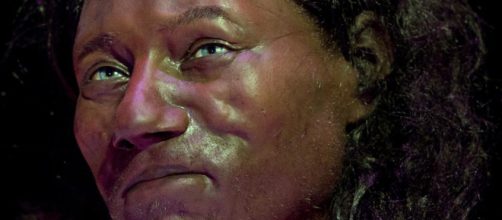A 10,000-year old reconstructed skeleton found in Gough’s Cave in Cheddar Gorge in Somerset, England a hundred years ago, has now had a full sequence of DNA analysed.
It was found to be a male of approximately five foot five, ten stone in weight, and had dark skin and blue eyes.
The secrets of the First Brit was unveiled on TV Channel 4
An exciting programme on the UK’s Channel 4 (C4) has revealed many of the secrets of the ancient specimen of the so-called ‘First Brit’. The well-preserved skeleton is now kept on display at the Natural History Museum in the Red Zone, the section on Human Evolution and curated by Chris Stringer who has written several books on ancient genetics.
In this section of the Natural History Museum, there are several life-size reproductions of various branches of the Homo- family species, including, for example, a realistic model of Homo Neanderthensis. A decision was made to undergo a project to recreate a similar model of how ‘Cheddar Man’ might have looked.
A project was initiated to recreate a model of Cheddar Man from DNA findings
The fresh DNA sequencing project was set up by the specialist team at the Museum. This was to be done by attempting to retrieve fresh DNA from the skeleton on display. The next step would be to sequence the DNA if any. With very old specimens, there is a real chance the DNA will have deteriorated, due to such things a bacterial decay, or the weather.
Thanks to the sealed off and sheltered limestone conditions of Gough’s Cave, the likelihood of this was much lessened.
The team undertook to drill a 2mm hole into the petrous bone of the skull, which is found inside the inner ear. It then had to wait two weeks, to discover whether there was any usable DNA. To great excitement, the project was successful and the resulting data sent to University College London for further analysis.
Dutch twins recreate the face
In the meantime, Dutch forensic modellers, Adrie and Alfons Kennis, artists in two-dimensional and three-dimensional paleontological reconstructions, had modelled Cheddar Man’s skull by intricate digital scanning, as used by the NASA Space Station, which was then sent to a 3-D printer.
Not so long ago, this would have taken weeks – and the DNA sequencing up to three years – but nonetheless, it still took nineteen hours to reproduce the precise 3-D measurements. The identical twins then had to await the DNA results to find out what colouring and hair type to assign their model.
Dr Yoan Diekmann of UCL reported back on the likely skin colour, which can be placed into five different categories, depending on the combination of gene markers identified with skin tones. Dr. Tom Booth of the Natural History Museum predicted on C4 TV the specimen would have curly hair, similar to his own as he had the same marker for this type of hair. Eye colour is dependent on yet another gene. The biggest surprise for the team and the national press is that Cheddar Man was found to be probably in the darkest skin category, but yet had pale blue eyes.
This is not a combination often seen today.
The reconstruction of Cheddar Man is unveiled at the Natural History Museum
Thus, when the model of Cheddar Man was unveiled at the Natural History Museum a few weeks ago, there were gasps of delight and astonishment at the model's features, including a ‘small face’, ‘delicate jaw’ and ‘very broad cheeks and brow’
Dr Chris Stringer explained to viewers that Cheddar Man’s genetic profile was very similar to the ancient specimens found in Europe, such as in Loschbour in Luxemburg, the Hungarian ones, the 7,000-year one in La Brana Arintero in Spain and the other in Germany. These, too, are believed to have the combination of dark skin and blue eyes. They are labelled ‘Western European Hunter-Gatherers’ and believed to have spread across Europe after the last Ice Age thawed some 10K years ago, migrating from the Middle East from their ancestral home of Africa in pursuit of game, such as red deer, oxen and wild boar.
ANCIENT DNA
Cheddar Man’s Mesolithic - Western Europe Hunter Gatherer Contemporaries
Nomenclature Age Haplotype
Loschbour Lux 8,000 U5b1a
KO1 2, Hungary 7,700 R
NE1 Hungary 7,200 U5b2c
NE6, Hungary 7,100 K1a3a3
NE5, Hungary 7,100 T2a1a
LBK Stuttgart 7,000 T2c2
Motala-12, Swe 7,000 U2e1
La Brana, Spain 7,000 C6
NE7, Hungary 6,400 N1a
‘All Britons share 10% of Cheddar Man’s DNA’
The project also included taking DNA samples from volunteers in the modern-day Cheddar region of Somerset. All of them were found to share DNA traces with Cheddar Man. The surprise finding is that all modern day indigenous Brits share this, too, with about 10% of British DNA shared with Cheddar Man.
Cheddar Man has previously been sequenced by Brian Sykes
The Cheddar Man did have its DNA sequenced by Oxford University geneticist Brian Sykes, some years ago, from drilling into a tooth. However, some scientists have disputed whether contamination had been fully guarded against, as the U5 haplotype finding was also the haplotype of one of his lab assistants. U5 is, however, a very early European haplotype, so cannot be ruled out as inauthentic. The programme did not state the haplotype found for Cheddar Man in its own sequencing. Methods and techniques have developed substantially in recent years.
‘Cheddar Man has no connection to earlier cannibal tribe’
It was found to have no direct ancestry to a cannibalistic tribe aged some five thousand years earlier whose bones were found in the same cave.
The bones showed evidence of chew marks made by human teeth, and the bones cut with a sharp implement. The skulls had been used as a drinking cup, in what is believed to have been used in rituals to honour their dead.


